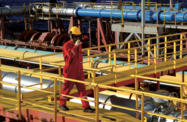Saudi Arabia has boosted oil production to near record highs, reaching levels of output and exports not seen since before the global economic crisis. According to official data issued in mid-August by the Joint Organisation Data Initiative (JODI), Saudi Arabia increased its crude oil production from 8.89m barrels per day (bpd) in May to 9.76m bpd in June, with overseas shipments averaging 7.38m bpd, the highest since October 2008.
Although as the only substantial “swing state” oil producer the Kingdom made a commitment to meet any shortfall in global supply caused by the halting of production in Libya, which has caused a fall in global output by an estimated 1.2m bpd, the reason behind the increase is also domestic in nature.
Having launched a long-term investment programme that dedicates almost $400bn to housing projects, infrastructure and economic development schemes, health and education, Saudi Arabia also needs the additional income to fund these projects. If international crude prices stay at or above $90 per barrel, the Kingdom should be able to keep its budget in the black. However, with crude oil prices fluctuating, in part due to concerns that many major economies will return to a recession, Riyadh may be looking at quantity over high prices.
In early August the Organisation of Petroleum Exporting Countries (OPEC) lowered its projection for the expected increase in global oil consumption, stating that demand was now forecast to grow by 1.2m bpd in 2011 to an average of 88.14m bpd, a downward revision of 150,000 barrels.
“Economic worries along with high oil prices have affected the Organisation for Economic Cooperation and Development (OECD) oil demand, leading to weaker-than-expected consumption during the summer driving season,” said OPEC. “Oil demand in the OECD is expected to continue its contraction after a temporary rebound last year.”
Even if Saudi Arabia’s export markets were to shrink along with crude oil prices, and the Libyans were able to resume exports,, the Kingdom’s 260.7bn barrels of oil in reserve, $506m in foreign assets and substantial reserve funds should mean that any short-term deficit will easily be covered.
Domestic demand is another factor in Saudi Arabia’s increased output. Many of the Kingdom’s power stations run on oil and the increased use of air conditioners in the hot season causes demand on the electricity grid to spike sharply. Therefore, greater quantities of oil are required to meet annually increasing electricity usage during the summer months.
With industrialisation also accelerating and the population growing, domestic demand is climbing. The Kingdom needs to focus on a long-term strategy to cope with this growing need for oil, or electricity generated by oil, in the local economy.
Reining in domestic oil consumption, or finding alternative sources for generating electricity, would be beneficial in increasing the amount of oil available for export, which could fall significantly if current conditions continue.
According to a statement issued on August 17 by JODI, domestic consumption in June eased to an average of 1.89m bpd, compared with 1.98m in May, and an increase from the 1.83m bpd consumed a year earlier. Although data on the amount of oil used in the two hottest months – July and August – are not due to be released for quite some time, many analysts predict that the dip was an exceptional event.
A recent study by the Riyadh-based finance house Jadwa Investment warns that the continued rise in domestic oil demand, combined with a weaker rate of price increases, could put a strain on government finances, especially given the far higher expenditures projected for the next five years or so.
“While we think prices will continue to rise, we do not think they will rise at the rate required to meet the break-even price for the budget,” the report said. “Indeed, a decade-long plateau in oil prices, as the market has previously experienced, would likely lead to a rapid deterioration of the Kingdom’s future fiscal position.”
Of course, these concerns are based on the supposition that the state’s spending levels will continue to rise at the present rate. Much of this spending, however, is in the form of investments, aimed at further diversifying the economy and securing the well-being of the nation’s citizens.
While many Saudis may be looking forward to the cooler weather of autumn, the country’s oil industry, striving to fund the future of the Kingdom, will probably be running hot for some time to come.

